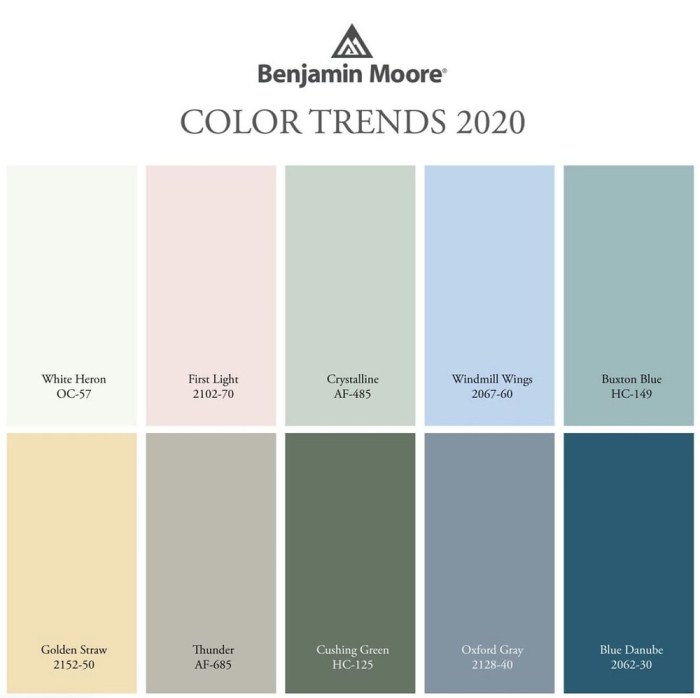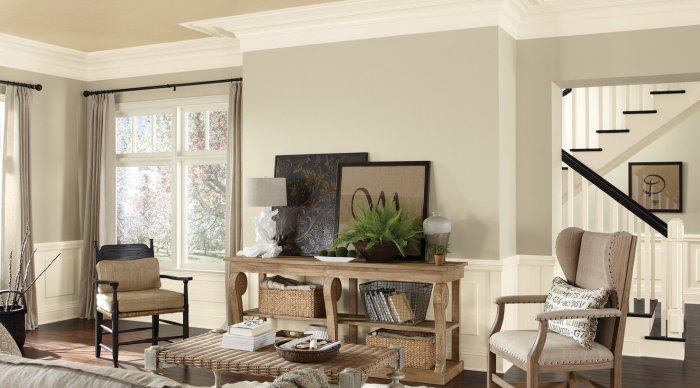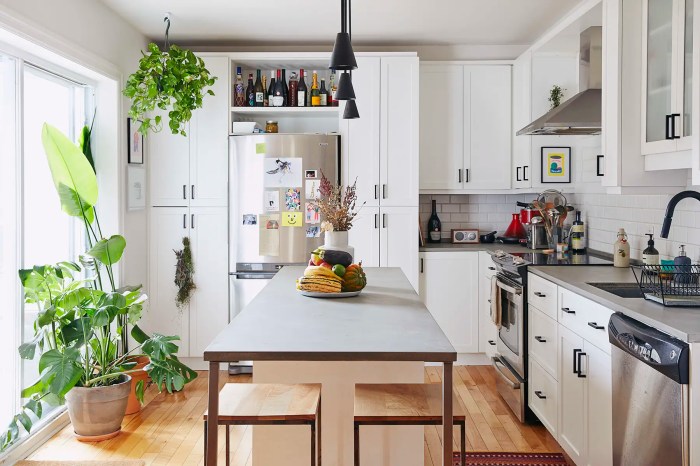
In the ever-evolving world of home design, paint colors play a pivotal role in shaping the ambiance and aesthetic appeal of our living spaces. As we embark on new home improvement projects in 2024, understanding the latest paint color trends is essential for creating a stylish and inviting atmosphere that reflects our personal style and preferences.
From the calming hues of nature-inspired palettes to the vibrant accents of bold and contemporary shades, the choices are endless. This guide explores the top paint colors for 2024, delving into their psychological effects, design applications, and the key factors driving their popularity. Whether you’re looking to refresh a single room or embark on a complete home makeover, understanding the nuances of color selection can make all the difference in achieving your desired outcome.
Trending Paint Colors for 2024

A fresh coat of paint can instantly transform a room, making it feel more inviting, modern, or simply brighter. As we step into 2024, certain paint colors are poised to dominate home improvement projects, reflecting evolving design trends and cultural preferences. These colors are not merely about aesthetics; they evoke emotions, create ambiance, and influence how we experience our living spaces.
Top 10 Trending Paint Colors for 2024
The following table showcases the top 10 trending paint colors for 2024, along with their color codes, families, and descriptions. These colors are chosen based on their popularity among designers, architects, and homeowners, as well as their ability to complement diverse interior styles and create a sense of well-being.
| Color Name | Color Code (HEX) | Color Family | Description |
|---|---|---|---|
| Sage Green | #87A96B | Green | Sage green evokes a sense of tranquility and connection to nature. It’s a versatile color that works well in both modern and traditional settings, creating a calming and sophisticated ambiance. |
| Terracotta | #E87452 | Red | Terracotta brings warmth and a touch of rustic charm to any space. It’s perfect for creating a cozy and inviting atmosphere, especially in living rooms and dining areas. |
| Dusty Rose | #D8BFD8 | Pink | Dusty rose offers a soft and romantic touch, adding a subtle elegance to bedrooms and bathrooms. Its muted hue creates a sense of calm and serenity. |
| Deep Teal | #008080 | Blue | Deep teal is a sophisticated and dramatic color that adds depth and intrigue to any room. It’s particularly well-suited for creating a luxurious and modern feel in living rooms and home offices. |
| Soft Blue | #ADD8E6 | Blue | Soft blue evokes a sense of peace and tranquility, making it ideal for bedrooms and bathrooms. Its calming effect promotes relaxation and restful sleep. |
| Warm Gray | #999999 | Gray | Warm gray is a neutral color that provides a versatile backdrop for various design styles. It’s both calming and sophisticated, making it suitable for living rooms, kitchens, and bedrooms. |
| Golden Yellow | #FFD700 | Yellow | Golden yellow brings a touch of sunshine and warmth to any room. It’s perfect for creating a cheerful and inviting atmosphere, especially in kitchens and dining areas. |
| Navy Blue | #000080 | Blue | Navy blue is a classic and sophisticated color that adds a touch of formality and elegance to any space. It’s particularly well-suited for creating a dramatic and luxurious feel in living rooms and dining areas. |
| Burnt Orange | #CC5500 | Orange | Burnt orange adds a touch of warmth and vibrancy to any room. It’s perfect for creating a cozy and inviting atmosphere, especially in living rooms and dining areas. |
| Pale Lavender | #E6E6FA | Purple | Pale lavender evokes a sense of tranquility and sophistication, making it ideal for bedrooms and bathrooms. Its calming effect promotes relaxation and restful sleep. |
Choosing the Right Color for Different Rooms
Selecting the perfect paint color for each room in your home can significantly impact its overall feel and functionality. Color can influence mood, perception of space, and even how you interact with the room. Understanding the psychological effects of color and applying them strategically can create a harmonious and inviting environment.
Color Palette for Different Rooms
Choosing the right paint colors for different rooms is essential to create the desired atmosphere and functionality. Here’s a table outlining the best paint colors for common rooms, their associated moods, and tips for choosing the right shades:
| Room Type | Color Palette | Mood | Tips for Choosing Paint Colors |
|---|---|---|---|
| Living Room | Neutral colors like beige, gray, or white, with pops of color through furniture, artwork, or throw pillows. | Relaxing, inviting, and versatile. | Consider the amount of natural light the room receives. Light colors can brighten a dark room, while darker colors can create a cozy and intimate ambiance. |
| Bedroom | Soft, calming colors like blues, greens, or lavender. | Peaceful, restful, and conducive to sleep. | Avoid stimulating colors like red or orange, as they can make it difficult to fall asleep. |
| Kitchen | Warm, inviting colors like yellow, orange, or red. | Energetic, stimulating, and appetite-inducing. | Consider the style of your kitchen. Modern kitchens might benefit from sleek, minimalist colors, while traditional kitchens might look best with warmer, more rustic shades. |
| Bathroom | Cool, refreshing colors like blue, green, or gray. | Clean, spa-like, and relaxing. | Choose colors that complement your bathroom fixtures and tiles. |
How Color Affects Room Size and Atmosphere
Color plays a crucial role in shaping the perception of space and atmosphere. Light colors, like white or pale blues, can make a room feel larger and more airy. Darker colors, like navy blue or deep green, can create a cozy and intimate ambiance but can make a room feel smaller.
“Light colors reflect light, making a room feel larger and brighter, while dark colors absorb light, creating a more intimate and cozy atmosphere.”
Creating a Harmonious Color Scheme
A harmonious color scheme involves selecting colors that complement each other and create a visually pleasing and balanced environment. There are several color schemes you can use:* Monochromatic: This scheme uses different shades of the same color, creating a sense of unity and sophistication. For example, using different shades of blue, from light sky blue to deep navy, can create a calming and cohesive look.
Analogous
This scheme uses colors that are next to each other on the color wheel, such as blue, blue-green, and green. These colors blend well and create a sense of harmony.
Complementary
This scheme uses colors that are opposite each other on the color wheel, such as red and green, or blue and orange. These colors create high contrast and visual excitement.
Triadic
This scheme uses three colors that are equally spaced on the color wheel, such as red, yellow, and blue. These colors create a vibrant and energetic feel.When choosing a color scheme, consider the overall style of your home and the desired mood for each room.
The Psychology of Color in Home Decor
Color is more than just a visual element in home decor; it profoundly influences our mood, behavior, and overall well-being. Understanding the psychological effects of different colors can help you create a space that reflects your personality and supports your desired atmosphere.
The Impact of Color on Mood and Behavior
Colors have a powerful effect on our emotions and can evoke a wide range of feelings. For instance, warm colors like red, orange, and yellow are associated with energy, excitement, and stimulation, while cool colors like blue, green, and purple are often linked to calmness, tranquility, and relaxation.
- Red: Red is a stimulating color that can increase heart rate and blood pressure. It’s often used to create a sense of excitement and energy, but it can also be overwhelming in large doses. Red is a good choice for dining rooms or home offices where you want to feel energized and focused.
- Orange: Orange is a vibrant and cheerful color that can boost creativity and optimism. It’s a great choice for living rooms or playrooms where you want to encourage fun and social interaction.
- Yellow: Yellow is associated with happiness, optimism, and intellect. It can be uplifting and stimulating, but too much yellow can be overwhelming. It’s a good choice for kitchens or home offices where you want to feel energized and focused.
- Blue: Blue is a calming and soothing color that can promote relaxation and peace. It’s often used in bedrooms or bathrooms to create a tranquil atmosphere. Blue can also be associated with feelings of trust and security.
- Green: Green is a color that evokes feelings of nature, tranquility, and harmony. It’s a good choice for living rooms or bedrooms where you want to create a relaxing and peaceful environment. Green can also be associated with feelings of growth and renewal.
- Purple: Purple is a color that is often associated with luxury, creativity, and spirituality. It can be calming and relaxing, but it can also be overwhelming in large doses. Purple is a good choice for bedrooms or home offices where you want to create a sense of peace and tranquility.
Sustainable Paint Options for Home Improvement

As homeowners become increasingly aware of their environmental impact, sustainable paint options are gaining popularity. These eco-friendly paints are designed to minimize harm to the environment throughout their lifecycle, from manufacturing to disposal.
Types of Eco-Friendly Paints
Choosing eco-friendly paint is a great way to reduce your environmental impact and create a healthier indoor environment. Here are some of the most common types of sustainable paints available on the market:
- Low-VOC Paints: VOCs (volatile organic compounds) are chemicals released into the air during the drying process of traditional paints. These compounds can contribute to air pollution and indoor air quality issues. Low-VOC paints emit significantly fewer VOCs, making them a healthier choice for both the environment and your home.
- Water-Based Paints: Water-based paints use water as their primary solvent, making them a more sustainable option than oil-based paints. They are typically lower in VOCs, dry faster, and are easier to clean up.
- Plant-Based Paints: Plant-based paints use natural ingredients derived from plants, such as resins, oils, and pigments. These paints are often biodegradable and non-toxic, making them a good choice for sensitive individuals and children.
- Recycled Content Paints: Some paint manufacturers use recycled materials in their paint formulations, such as recycled plastic or glass. This reduces the need for virgin materials and helps conserve resources.
Comparing and Contrasting Sustainable Paint Options
Each type of eco-friendly paint has its own set of features and benefits:
| Paint Type | Features | Benefits |
|---|---|---|
| Low-VOC Paints | Lower VOC emissions, faster drying time, good adhesion | Improved indoor air quality, reduced environmental impact, healthier for occupants |
| Water-Based Paints | Water-based solvent, easy cleanup, fast drying | Lower VOCs, less odor, environmentally friendly, suitable for various surfaces |
| Plant-Based Paints | Natural ingredients, biodegradable, non-toxic | Reduced environmental impact, safer for children and pets, promotes sustainability |
| Recycled Content Paints | Use of recycled materials, reduced reliance on virgin materials | Conserves resources, promotes a circular economy, minimizes environmental impact |
Sustainable Paint Brands
Several paint manufacturers are committed to sustainability and offer a wide range of eco-friendly paint options. Here are a few examples:
- Sherwin-Williams: Offers a line of low-VOC paints and water-based paints, as well as recycled content paints.
- Benjamin Moore: Known for its Aura line of low-VOC paints, which provide excellent coverage and durability.
- Valspar: Offers a variety of sustainable paint options, including low-VOC, water-based, and plant-based paints.
- Green Planet Paints: Specializes in plant-based and natural paints that are non-toxic and biodegradable.
Environmental Impact of Paint Choices
The paint you choose can have a significant impact on the environment. Traditional paints often contain harmful chemicals that can pollute the air, water, and soil.
“The production and disposal of paint can contribute to greenhouse gas emissions, air and water pollution, and landfilling.”
Therefore, choosing sustainable paint options can help reduce your environmental footprint.
Responsible Paint Disposal
Properly disposing of leftover paint is essential for protecting the environment.
- Never pour paint down the drain or into the sewer system. These actions can contaminate water supplies and harm aquatic life.
- Check with your local waste management facility for proper disposal guidelines. Many facilities offer paint recycling programs.
- Consider using up leftover paint on smaller projects or donating it to community organizations.
Home Improvement Straw
In the realm of sustainable construction, a unique and eco-friendly approach has emerged, utilizing a readily available material: straw. Straw bale construction, a practice gaining traction, offers an innovative and environmentally conscious alternative to traditional building methods.
Straw Bale Construction: An Eco-Friendly Approach
Straw bale construction involves using tightly packed bales of straw as a building material, offering a sustainable and cost-effective option for home improvement projects. This method leverages the natural insulation properties of straw, reducing energy consumption for heating and cooling, while minimizing the environmental impact associated with conventional building materials.
Materials Used in Straw Bale Construction
Straw bale construction utilizes a range of materials, each contributing to its environmental benefits:
- Straw Bales: The core component, these bales are made from dried stalks of cereal grains like wheat, barley, or rye, offering excellent insulation and thermal mass. Their natural properties contribute to a comfortable indoor climate, reducing energy demands for heating and cooling.
- Clay Plaster: Used for both interior and exterior finishes, clay plaster is a natural, breathable material that regulates humidity and creates a healthy indoor environment. It’s made from clay, sand, and water, making it an environmentally friendly choice.
- Timber Framing: Providing structural support, timber framing is typically used for the walls, floors, and roof of a straw bale home. Choosing sustainably sourced timber minimizes the environmental impact associated with wood harvesting.
- Recycled Materials: Straw bale construction encourages the use of recycled materials for windows, doors, and other components, further reducing the overall environmental footprint.
Advantages of Straw Bale Construction
Straw bale construction offers a range of advantages for home improvement projects:
- Energy Efficiency: Straw bales provide excellent insulation, reducing energy consumption for heating and cooling, leading to lower utility bills and a smaller carbon footprint.
- Cost-Effectiveness: Straw bales are a relatively inexpensive building material, making straw bale construction a cost-effective option for home improvement projects.
- Environmental Sustainability: By utilizing a readily available, renewable resource, straw bale construction promotes sustainability and reduces reliance on traditional building materials with higher environmental impacts.
- Indoor Air Quality: Natural materials like straw and clay plaster contribute to improved indoor air quality, creating a healthier living environment.
Disadvantages of Straw Bale Construction
While straw bale construction offers numerous advantages, it also presents some challenges:
- Moisture Management: Straw bales are susceptible to moisture damage, requiring careful design and construction techniques to ensure proper ventilation and drainage.
- Fire Resistance: While straw bales are inherently fire-resistant, proper fire safety measures are essential, including the use of fire-retardant treatments and smoke detectors.
- Availability of Skilled Labor: Finding skilled labor experienced in straw bale construction can be challenging, potentially increasing project costs and timelines.
- Aesthetic Considerations: The rustic appearance of straw bales may not appeal to all homeowners, requiring careful design and finishing techniques to achieve desired aesthetic outcomes.
Successful Straw Bale Homes: Examples and Impact
Numerous successful straw bale homes have been built worldwide, demonstrating the viability and environmental benefits of this construction method. These homes showcase the ability of straw bale construction to achieve high levels of energy efficiency, indoor comfort, and aesthetic appeal.
- The Straw Bale House in England: Built in 2002, this home features thick straw bale walls and a clay plaster finish, achieving exceptional energy efficiency and a comfortable indoor climate. It serves as a model for sustainable living, showcasing the potential of straw bale construction.
- The Straw Bale House in California: Constructed in 2008, this home utilizes straw bales for insulation and structural support, achieving a high level of energy efficiency and a minimal environmental impact. Its design showcases the versatility of straw bale construction for various architectural styles.
- The Straw Bale School in Colorado: This school building, completed in 2010, utilizes straw bales for insulation and structural support, demonstrating the potential of straw bale construction for large-scale projects. It showcases the durability and sustainability of this construction method.
Choosing the right paint colors for your home improvement projects can be a transformative experience. By considering the psychological effects of color, exploring the latest trends, and understanding the nuances of different palettes, you can create a space that is not only aesthetically pleasing but also reflects your personality and enhances your overall well-being. From vibrant accents to calming neutrals, the power of paint lies in its ability to create a sense of harmony, evoke emotions, and ultimately, make your home a true reflection of your unique style.
Essential Questionnaire
What are some of the most popular paint colors for bedrooms in 2024?
Popular bedroom paint colors in 2024 include calming blues, serene greens, and warm neutrals that promote relaxation and restful sleep.
How can I use color to make a small room feel larger?
Using lighter shades of paint, such as whites, creams, or pale blues, can create an illusion of space in smaller rooms. Avoid using dark colors, as they can make a room feel cramped.
What are some sustainable paint options available in the market?
Sustainable paint options include low-VOC paints, plant-based paints, and recycled content paints, all designed to minimize environmental impact.




